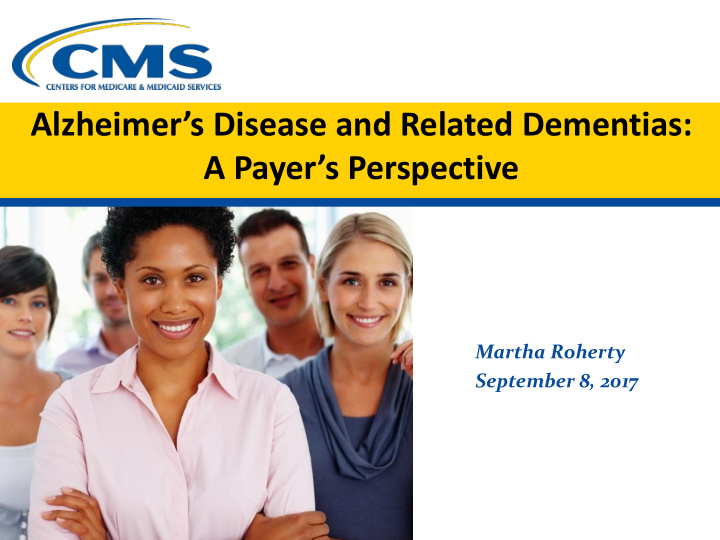



Alzheimer’s Disease and Related Dementias: A Payer’s Perspective Martha Roherty September 8, 2017
2017 Top Priorities for Aging &Disability Agency Leadership 1. Ensuring Compliance with the Medicaid Home and Community-based Services Regulation 2. Adult Protective Services and Elder Justice 3. Improving Quality Across Programs 4. Managed Long-Term Services and Supports 5. Implementing the Long-term Care Ombudsman Regulation 6. Addressing Senior Hunger, Nutrition, and Food Insecurity 7. Services for Individuals with Alzheimer’s and Related Dementia
Federal Programs Supporting Alzheimer’s Care • Medicare —inpatient hospital care; some doctor’s fees; some medical items; outpatient drugs; some home health under certain conditions but does NOT pay for person to assist with daily activities or long term nursing home care • Medicaid — is based on both functional and financial eligibility and varies state by state. If eligible, Medicaid will pay for nursing home care and if qualitied under HCBS waiver program — pay for services in home and community settings. • Older Americans Act — everyone 60 and over is eligible but because of limited funding must meet targets. 3
Average Cost of Care 4
Average Cost of Care 5
Average Cost of Care 6
Examples of OAA Funded Services for Individuals with Dementia • • Adult Day Health/Adult Day Legal Assistance Services • LIHEAP • D e mentia Support Groups • Personal Care • Case Management • Senior Centers • Congregate/Home Delivered • Respite Meals • Information & • Family Caregiver Support Referral/Options Counseling • Homemaker • Independent Living 7
Current OAA Clients & Potential Eligibles 140,000,000 120,000,000 100,000,000 Number of Persons 80,000,000 Number of Persons 60 and Above 60,000,000 Age 60 and above & Below 250% FPL 40,000,000 Age 60 and above & Below 200% FPL 20,000,000 Number of Persons Receiving OAA Services 0 2010 2011 2012 2013 2014 2015 Year Source: NASUAD Analysis of U.S. Census (Current Population Survey) and AGID Data 8
Change in Medicaid HCBS Expenditures FY15-FY16 (for specific populations) Children with ID/DD Individuals with Traumatic or Acquired Brain Injuries Adults with Behavioral Health Conditions Adults with Physical Disabilities Older Adults (age 65+) Adults with ID/DD Adults with Autism Spectrum Disorder Alzheimer's disease and related dementias 0 5 10 15 20 25 30 35 Number of States Stayed the Same Decreased Increased 9
Change in Medicaid HCBS Caseload FY15-FY16 (for specific populations) Children with ID/DD Older individuals with ID/DD (age 65+) Individuals with Traumatic or Acquired Brain Injuries Adults with Behavioral Health Conditions Adults with Physical Disabilities Older Adults (age 65+) Adults with ID/DD Adults with Autism Spectrum Disorder Alzheimer's disease and related dementias 0 5 10 15 20 25 30 35 Number of States Stayed the Same Decreased Increased 10
Adult Day Centers Provide Medical Services 11
Residential Settings that May not Meet Requirements Residential Settings that May not Meet Requirements 20 18 16 Number of States 14 12 10 8 6 4 2 0 12
Importance of Caregiving 13
The Growing Value of Caregiving 14
Profile of Caregivers in America 15
16 For more information, please visit: www.nasuad.org • Or call us at: 202-898-2578
Recommend
More recommend